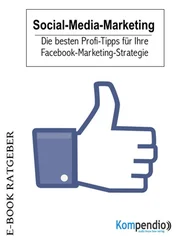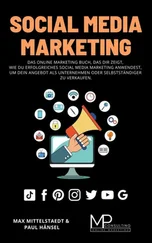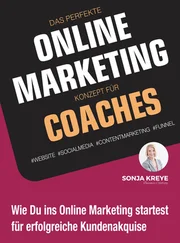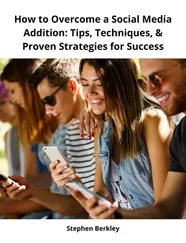The true power of social media marketing comes from applying its principles to all parts of your business in a rigorous fashion. This begins with examining social media marketing in relation to your marketing funnel. You then need to understand how it relates to brand marketing and direct response — the two traditional pillars of marketing that support the marketing funnel. Understanding the differences helps you to better know when to deploy social media marketing tactics versus when to depend upon brand or direct-response tactics.
In this chapter, we also discuss how big and little ideas relate to social media marketing. The marketing world has historically been driven by the big ideas. Whether it’s been the glamorous advertising (Apple’s iconic 1984 commercial comes to mind) or the clever in-store promotions that you see when you walk down the aisle at your local Whole Foods, ideas drive marketing. That changes with social media marketing. We explain how you need to think about the big idea a little differently as you deploy social media marketing to meet your marketing and business objectives.
Putting SMM in the Context of the Marketing Funnel
The marketing funnel is one of the most important metaphors in marketing today. It differentiates between prospects and customers, and maps out the journey from the point where a prospect learns about a product to when he becomes a loyal, repeat customer. Because practically every marketer uses some form of the marketing funnel, it serves an important framework through which to understand social media marketing.
The traditional marketing funnel typically has five stages, as defined by Forrester. These five stages are awareness, consideration, preference, action, and loyalty (as shown in Figure 3-1). The last stage (loyalty) has the fewest people. Those customers are the most loyal and, therefore, among the most valuable. For many marketers, marketing is fundamentally the act of moving people from having an awareness of a product, considering it along with other products, and establishing a preference for the product over the others, to eventually taking action such as purchasing it and developing loyalty toward it.
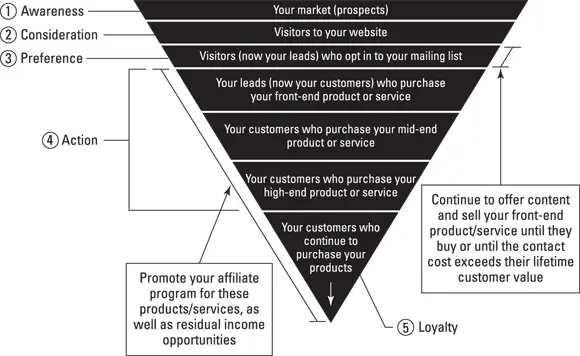
FIGURE 3-1:A marketing funnel.
You employ different marketing strategies and tactics at every stage of the marketing funnel to move the prospects along. The movement of prospects and customers is measured precisely (especially when you do this online), and if there isn’t enough movement, you need to devote more marketing dollars to pushing people through the funnel. How you spend these dollars and which investments do the most to move people through the marketing funnel is always a subject of much debate and varies by product category. Regardless, social media marketing and tapping into the social influencers with differing tactics can help with this journey.
 The stages of the marketing funnel may vary from company to company. In some cases, it has changed significantly with the advent of everything digital; for others the fundamental marketing funnel is the same. Some link online funnel tracking with offline efforts, whereas others don’t. You don’t have to rigorously use the stages as we define them. It’s more important that you look at SMM in the context of how your company builds its brand, drives awareness for its products, tracks leads, enables sales, and manages loyalty. In some cases, you need to consider how you can apply SMM at the different points in an advertising campaign. Regardless, the same principles apply whether you’re looking at SMM in the context of the funnel for your entire marketing efforts or for just an online advertising campaign.
The stages of the marketing funnel may vary from company to company. In some cases, it has changed significantly with the advent of everything digital; for others the fundamental marketing funnel is the same. Some link online funnel tracking with offline efforts, whereas others don’t. You don’t have to rigorously use the stages as we define them. It’s more important that you look at SMM in the context of how your company builds its brand, drives awareness for its products, tracks leads, enables sales, and manages loyalty. In some cases, you need to consider how you can apply SMM at the different points in an advertising campaign. Regardless, the same principles apply whether you’re looking at SMM in the context of the funnel for your entire marketing efforts or for just an online advertising campaign.
SMM at the awareness stage
The awareness stage of the marketing funnel is where you introduce potential customers to your brand. You build awareness and encourage prospective customers to remember your brand name so that when they do make a purchase in the future, they include your brand in their consideration mix.
Typically, marketers use television, radio, print, and direct mail to build awareness. They also sponsor events, conduct promotions, and invest in product placements to get further exposure. Marketers also use public relations professionals to influence editorial content in magazines and newspapers.
In the digital realm, you typically create awareness using display advertising on major websites, paid searches for category-related keywords, video advertising on YouTube and Facebook, and sponsorships across the web. Email marketing has also been successful at building awareness. Historically, creating awareness online is a lot cheaper but without the same mass scale effect of a 30-second television spot.
You can use social media marketing to build awareness of your brand, too. The reason is simple: As a marketer with a loyal customer base, you can encourage your customers to build your brand by talking about your product with their friends. Many a marketer has incentivized existing customers to tell their friends and families about their purchasing decisions. You aren’t the first. In fact, you can also reach out to expert influencers to help you here. One important consideration with using social media marketing at the awareness stage is whether your SMM efforts can give you the type of scale that you can get with television, radio, or print. For a long time, marketers believed that social media marketing couldn’t give that scale. That’s changing fast, thanks to the likes of Facebook, YouTube, Google, and Twitter, which are now among the most trafficked websites on the Internet. In fact, marketers now recognize that you can get as much scale and often much more efficiently as TV could in the past. Some brands have moved toward a digital-only model for all their marketing efforts as a result.
 Expert influencers are the people who are experts in a field and have large audiences.
Expert influencers are the people who are experts in a field and have large audiences.
Here are some SMM tactics to consider for building awareness:
Publish video advertisements to YouTube and tag them with category terms.For example, if you’re publishing advertisements for orange juice on YouTube, use the tags orange, orangejuice, beverage, vitamin, and drink in addition to the brand name. Highlight these YouTube video clips on the corporate website, too. As you do this, first consider whether your advertisement is YouTube ready: Would people enjoy viewing it, would they share it, should it be longer, does it evoke strong emotion, and is it truly enjoyable? Figure 3-2 shows whether your orange juice video would be in good company on YouTube.
Nurture relationships with expert influencers, such as YouTube and Instagram influencers, who publish content related to the specific product category you’re marketing.Take the time to share product samples with these influencers, answer their questions, and invite them to special events. If required, sponsor a post on an influential blog. These expert influencers build awareness for your brand in ways that your customers may be more responsive to.
Set up a Facebook fan page, a Twitter account, and a LinkedIn profile.Run polls, offer special discounts, publish games, promote coupons, and give members of these pages or accounts product sneak peeks. Share entertaining and educational information through them. Boost that content with paid advertising so that it reaches the right people. FIGURE 3-2:Does your orange juice video belong here?
Читать дальше
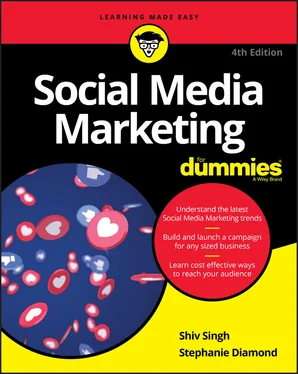

 The stages of the marketing funnel may vary from company to company. In some cases, it has changed significantly with the advent of everything digital; for others the fundamental marketing funnel is the same. Some link online funnel tracking with offline efforts, whereas others don’t. You don’t have to rigorously use the stages as we define them. It’s more important that you look at SMM in the context of how your company builds its brand, drives awareness for its products, tracks leads, enables sales, and manages loyalty. In some cases, you need to consider how you can apply SMM at the different points in an advertising campaign. Regardless, the same principles apply whether you’re looking at SMM in the context of the funnel for your entire marketing efforts or for just an online advertising campaign.
The stages of the marketing funnel may vary from company to company. In some cases, it has changed significantly with the advent of everything digital; for others the fundamental marketing funnel is the same. Some link online funnel tracking with offline efforts, whereas others don’t. You don’t have to rigorously use the stages as we define them. It’s more important that you look at SMM in the context of how your company builds its brand, drives awareness for its products, tracks leads, enables sales, and manages loyalty. In some cases, you need to consider how you can apply SMM at the different points in an advertising campaign. Regardless, the same principles apply whether you’re looking at SMM in the context of the funnel for your entire marketing efforts or for just an online advertising campaign.
